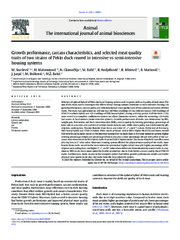Приказ основних података о документу
Growth performance, carcass characteristics, and selected meat quality traits of two strains of Pekin duck reared in intensive vs semi-intensive housing systems
| dc.creator | Starčević, Marija | |
| dc.creator | Mahmutović, Hava | |
| dc.creator | Glamočlija, Nataša | |
| dc.creator | Bašić, Meho | |
| dc.creator | Andjelković, R. | |
| dc.creator | Mitrović, Radmila | |
| dc.creator | Marković, Radmila | |
| dc.creator | Janjić, Jelena | |
| dc.creator | Bošković, Marija | |
| dc.creator | Baltić, Milan Ž. | |
| dc.date.accessioned | 2021-04-27T11:06:33Z | |
| dc.date.available | 2021-04-27T11:06:33Z | |
| dc.date.issued | 2021 | |
| dc.identifier.issn | 1751-7311 | |
| dc.identifier.uri | https://vet-erinar.vet.bg.ac.rs/handle/123456789/2045 | |
| dc.description.abstract | Selection of optimal hybrid of Pekin duck and housing system could improve yield and quality of duck meat. The aim of this study was to investigate the effects of two rearing systems (intensive vs semi-intensive housing) on growth performance, carcass quality, and selected physical meat quality traits of two commercial strains of Pekin ducks. The study was performed on 240 one-day-old Pekin ducklings of two different strains (120 ducklings of STAR 53 medium hybrid and 120 ducklings of SM3 heavy hybrid) during a 49-day period. Half the birds (120) were reared in a complete confinement system on a floor (intensive system), while the remaining 120 ducks had access to land outside (semi-intensive system). Growth performance of ducks was determined by BW, weight gain, feed intake, and feed conversion ratio (FCR), carcass quality by dressing percentage, percentage of basic cuts in carcasses, and content of various tissues in basic cuts, while meat quality was determined by pH, drip loss, cooking loss, Warner-Bratzler shear force, and color (L*, a*, and b*) values. At the end of the study, SM3 heavy hybrid and STAR 53 hybrid Pekin ducks achieved similar BWs. Higher final BW and lower overall FCR were found in ducks reared in the intensive system than in ducks kept in the semi-intensive system. Higher dressing percentage, weight and percentage of breast, but also a lower percentage of back with pelvis in the carcasses were determined in SM3 hybrid ducks than in STAR 53 hybrid ducks. The strain of duck did not affect meat pH, drip loss, or L* color value. Moreover, housing system affected the physical meat quality of the ducks, since breasts from ducks reared in the semi-intensive system had higher initial meat pH, higher percentage of EZ-drip loss and cooking loss, and higher L*, a*, and b* values than did breasts from intensively-reared ducks. In conclusion, SM3 ducks were more suited for broiler production due to their better carcass quality than STAR 53 ducks. Furthermore, ducks reared in the intensive system had better growth performance results and better physical meat quality traits than did ducks from the semi-intensive system. | |
| dc.language | en | |
| dc.relation | info:eu-repo/grantAgreement/MESTD/Technological Development (TD or TR)/31034/RS// | |
| dc.relation.isreferencedby | https://doi.org/10.1016/j.animal.2022.100689 | |
| dc.relation.isreferencedby | https://vet-erinar.vet.bg.ac.rs/handle/123456789/3760 | |
| dc.rights | openAccess | |
| dc.rights.uri | https://creativecommons.org/licenses/by-nc-nd/4.0/ | |
| dc.source | Animal | |
| dc.subject | Carcass composition | |
| dc.subject | Growth rate | |
| dc.subject | pH | |
| dc.subject | Poultry | |
| dc.subject | Production system | |
| dc.title | Growth performance, carcass characteristics, and selected meat quality traits of two strains of Pekin duck reared in intensive vs semi-intensive housing systems | |
| dc.type | article | en |
| dc.rights.license | BY-NC-ND | |
| dcterms.abstract | Балтић, Милан Ж.; Махмутовић, Хава; Гламочлија, Наташа; Башић, Мехо; Митровић, Радмила; Марковић, Радмила; Јањић, Јелена; Бошковић, Марија; Старчевић, Марија; Aндјелковић, Р.; | |
| dc.citation.volume | 15 | |
| dc.citation.issue | 2 | |
| dc.citation.spage | 100087 | |
| dc.citation.rank | aM21 | |
| dc.identifier.wos | 000626639900018 | |
| dc.identifier.doi | 10.1016/j.animal.2020.100087 | |
| dc.identifier.scopus | 2-s2.0-85100643718 | |
| dc.identifier.fulltext | https://vet-erinar.vet.bg.ac.rs/bitstream/id/5587/1-s2.0-S1751731120300896-main.pdf | |
| dc.type.version | publishedVersion |

